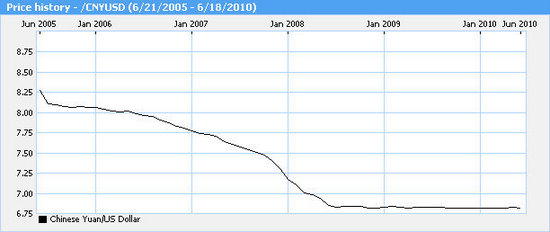
THE ANNOUNCEMENT from the People’s Bank of China cleverly nestled into the non-market moving weekend news that the yuan would be allowed to move more freely nevertheless spawned a spate of analysis on why Beijing was suddenly relenting, and who would be the biggest beneficiaries.
And by the lunchtime break today, the benchmark Shanghai Composite Index for Chinese A shares was up 1.96% while the Shenzhen Composite was up over 2%, suggesting that a fair number of investors were also aboard the domestic consumption bandwagon, and that external demand was no longer considered the sole lifeline of the domestic economy.
Meanwhile, the benchmark Hang Seng Index in Hong Kong was 0.74% higher at midday.
The PRC press feels that the biggest initial beneficiaries of a potentially stronger yuan will be airlines and paper makers, while clothing and machinery firms will be hit the hardest.
A stronger Chinese currency – the yuan – renders imports relatively cheaper and makes it harder for China’s export juggernaut to flood Walmarts and Targets overseas with a veritable panoply of cheaper products.
Therefore, the announcement from the People’s Bank of China on Saturday that it would begin refloating its currency after a nearly two-year de facto peg to the US dollar came as a surprise to most, as it represented a victory for the country’s central bank over the entrenched interests of exporters embodied in the political power of the Ministry of Commerce.
The latter has for years been pushing for a continued undervaluation of the renminbi relative to the US dollar in order to keep Chinese exports as the world’s most competitive – at least on a cost basis.
However, the sudden and apparent capitulation by Beijing over the weekend on the perennial exchange harangue left many analysts scrambling over the weekend to find root causes, and short-term impacts.
The general consensus among analysts is that the apparent retreat on the greenback peg is more politically than economically motivated.

The G20 is set to meet in Canada in a matter of days, and with China’s massive and unexpected first quarter export surge – coming as the rest of the industrialized world is mired in sovereign debt crises and unemployment woes – Beijing undoubtedly wanted to avoid ‘whipping boy’ status in Toronto.
In a separate note from CLSA Singapore today, China strategist Andy Rothman was cited as saying that the surprise move by the PBOC was likely to be more tactical than practical, and did not advise anyone to get hopes up too high about a sky high yuan anytime soon.
He believes initial appreciation will be “low,” somewhere in the neighborhood of 0.2% per month.
“But (it) will accelerate to 5-7% per year after Europe stabilizes.”
Other analysts also pointed to political reasons as prime movers for the purported de-peg.
"(Beijing) has taken the issue right off the table for the G20 and can refocus attention on what they see as the real problem for global financial stability -- rising government debt in the advanced economies, especially the US," the FT cited former IMF economist Eswar Prasad as saying.
Assumed Winners and Losers

Regardless of its motives, Beijing’s hint at considerably more exchange rate flexibility also means that different sectors will respond differently, depending on both and the nature of their upstream suppliers and the location of their downstream customers.
One of the chief beneficiaries of a stronger yuan – or anticipations thereof – is the country’s commercial aviation sector.
With purchase costs for foreign-made aircraft their biggest initial investment cost, and recurring aviation fuel costs also severely impacting profitability for carriers on an annual basis, a stronger yuan will help significantly ease financial burdens in both of these arenas.
Also, as domestic listed carriers like Air China, China Southern and China Eastern primarily serve a Chinese traveling public, and with the yuan in these travelers’ wallets suddenly worth more, passengers will certainly be taking to the skies more often.
Additionally, a stronger yuan makes honeymoons in Honolulu and pilsener pub-cations to Prague all the more affordable to China’s growing middle class ... and A-share or Hong Kong-listed Chinese carriers are more than willing to line up on tarmacs around the country to get passengers to their destinations.
Paper Profits

Analysts also expect China’s massive paper-making sector to reap big benefits from a stronger local currency.
With a huge reliance on imported pulp – prices of which can fluctuate erratically – listed Chinese papermakers like Nine Dragons are solid beneficiaries of cheaper imported raw materials.
This is especially true as the country’s paper industry has seen two decades of extremely rapid growth.
The China Paper Industry Association says that in 2007, China's consumption of paper was 72.90 mln tons and it produced over 73.50 mln tons to rank the No.2 globally.
And consumption is expected to reach 80 mln tons by 2010.
There are now over 3,600 paper mills in China. By the year 2010, experts predict at least 200 to 220 enterprises will be producing at least 100,000 tons.
Despite being a world leader in paper production, China is limited only by its lack of raw materials for making paper and has become more and more dependent on international pulp suppliers. China has imported over 26 million tons of pulp and waste paper for its mills. This figure will continue to grow in direct relation to its annual production growth rate.
Machinery and Clothing to Take Hit
The PRC media says that the sectors to see the biggest near-term hit from a stronger yuan will be machinery and clothing manufacturers.
This is primarily due to their heavy reliance on imported commodities like finished steel and cotton, as well as their very high dependence on external demand to keep them afloat.
Also, a whole raft of developing countries is vying to eat away at China’s dominance in machinery and clothing, and they are all too happy to see a stronger yuan.
See recent China shares report here







